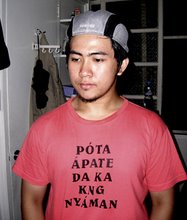Urban Kamaru
Central Luzon Daily
After watching the animated fantasy film ‘Dayo: Sa Mundo Ng Elementalia’ last Christmas, I at once bought a ticket to the cinema featuring Viva Films’ period love story ‘Baler,’ starring Jericho Rosales and Anne Curtis. Interested in both the historical and the regional aspect of the movie, ‘Baler’ was among the Metro Manila Film Fest entries of 2008 that I ascertained myself to not miss.

My trip to Baler
The municipality of Baler is the kabisera of the province of Aurora, which, after being separated from Quezon Province, became an addition to Region III. Being in the north-easternmost part of Central Luzon, Aurora is not very known among the urban people of Region III. Thus, only a few know about its natural and cultural beauty, its economic promise as an agricultural hub and tourist attraction, and its history.
Together with a few members of the Advocacy for the Development of Central Luzon (ADCL), I went there and stayed for a night at one of the province’s state university. The season seems to be eternally wet, although rains do not get heavy; they are just limited from drizzles to slightly heavy downpours. Partnered with its lush green forests, the place makes respiration a psychologically uplifting experience. Given all these descriptions, one could conclude that the place is like a less urban Baguio, with a twist.
Imagine Baguio City with an ocean on its side—an ocean met with winds and waves strong enough to allow people to enjoy surfing. In Aurora’s case, this ocean is none other than Dagat Pasipiko, the Pacific Ocean, which one can read in the place’s souvenir shirts. Ilongots, Tagalogs, Ilocanos, Kapampangans, and Dumagats compose much of the population of the place.
Plant all year long
The wetness of the season all year long has been permitting the people of Aurora to turn any part of the year a planting season. Some people can plant rice in February, some in June, some in December. To add to the wetness of the season all year long, Baler is also abundant in free flowing fresh water.
The predicament however, in the aspect of rice, is the drying of the harvest. With little heat from the sun penetrating the gloomy clouds of Aurora, the “over-blesssed” rainy season has its share of toll.
But the government of Aurora, aided greatly by Sen. Edgardo Angara, started a very intelligent project that gives tangible evidence not only of the government’s good governance, but also wise governance. In partnership with a Korean firm, they have erected a facility that artificially dries the harvest. With this technology, farmers need not worry about the wet weather because they now have a huge facility that takes the role of the sun in drying using big machines. Further developments especially in the area of marketing present the potential of making Aurora an upcoming rice capital of the country.

Weeks ago, the Clark Development Corporation has given the province of Aurora a satellite office in Clark. In the coming months, it is becoming predictable that Pampanga and Aurora will be working closely with each other.
The film ‘Baler’

Dumagats and Ilongots, according to the Museo De Baler, are pointed to be the first inhabitants of the place. While some local and Kapampangan historians point to Kapampangans as early residents, a book published by Sen. Angara does not mention anything about this.

The name ‘Baler’ could have come from the word ‘balid,’ which in Kapampangan means tongue-twisted, but in another language spoken in the place, it means to return. According to the book, it could have also come from the old Tagalog word ‘balod,’ a certain mountain dove.
The Metro Manila Film Fest entry ‘Baler’ from Viva Films (Best Picture and a couple more awards) highlighted a romantic story during the siege of Baler in the Spanish-American transition. While the film did not mention anything about the residents of the place being Kapampangans, Kapampangans, to my surprise, were present in the story—in the form of Macabebe soldiers.
A friend and I, before the screening of the MMFF entries, were criticizing ‘Baler’ for getting Jericho Rosales as a Spaniard. “Anne Curtis looks more like a Spaniard compared to Echo,” my friend commented. Turned out, Rosales’ character, Celso, wasn’t pure Spanish. He was half-Spanish, half-Filipino. His Filipino blood came from his mother, whom Celso claimed was from Pampanga, making him a Spanish-Kapampangan.
But that’s not all. The other Filipino soldiers included in the Spanish army were always claiming that their homeland was Pampanga. Thus, they were Kapampangans.
While the film didn’t mention it directly, I have the best feeling that Celso, along with the other Filipino soldiers employed under the Spanish flag, were Macabebe warriors. The discourse whether Macabebe warriors were traitors was tackled shortly in the film, when the soldiers were conversing among themselves.
“Why are we treated as traitors to the country?” one soldier said. “We are just doing our duty—to keep peace and order.” This kind of sentiment really reminds me of disputes about the infamous brown soldiers from the riverbanks.








No comments:
Post a Comment